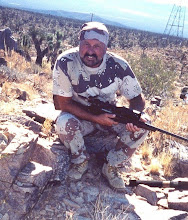I have been working hard for a while. It has also been very hot here in Southern California. It’s way too hot to venture into the Mojave Desert. There is no doubt about it, I have really got the itch to go hunting and I can’t wait to get out there again.
Before I get into the body of this message though, I have to relate a story that happened while serving aboard the last vessel. I was working aboard a ship that was doing training for errant young men. It was a boot camp on the water where we drilled the boys hard in physical training, lifeguarding, CPR, ship fire fighting, and several other disciplines. We also did several night operations to boost the boy’s confidence and challenge their fears.
Unknown to the boys, some of the training staff is placed on the beach (as shadow observers) in full camo to watch the boys operate and give assistance if there is an injury. On a moonless night, as several of us staff approached a remote beach by Zodiac on Santa Cruz Island, I was illuminating the shoreline with my super-bright green LED flashlight. All of a sudden I see a big set of eyes, right in the tree line by the water’s edge. I immediately get all jacked up and call out, “Eyes! I’ve got eyes!”. The instructors in the boat look at me like I’m nuts. They have no clue what I’m talking about. The eyes were big and shown bright green from my flashlight.
As we beached the Zodiac, the eyes were about 100-feet away and beginning to move through the brush and up the hillside. I explained to the guys what I was talking about and they began to get excited too. The only guy that wasn’t too excited was the guy we were leaving on the beach alone to wait for the cadets. He was a little freaked out because we couldn’t get a positive ID on the animal. What ever it was, moved up the hillside slowly and kept looking back at us. We guessed a deer, a goat, a pig, it was anybody’s guess what we saw. That did provide a bit of excitement for me though and made me think that I had to get out coyote hunting again soon.
Some quick coyote hunting tips for the new guys:
- Wind Direction: Always walk to your stand location into the wind. Don’t let your scent beat you there. Also, shoot your animal before he gets downwind or the game is up.
- Range the area: Use your rangefinder and range some key points in your field of fire.
- Anticipate: Position yourself facing the most likely direction the coyote will come in from. Have your partner cover your back.
- Equipment: Check your gear before each stand.
- Decoy: Use a decoy so the predator sees it and not you.
- Camo: Camo everything, especially your face and hands.
- Comfort: Get comfortable, stay still and have your rifle in position to shoot.
- Sounds: Be absolutely quiet walking into your stand and never skyline yourself. Take the low route and avoid cresting hills.
- Don’t overcall. Learn to use a howler and appeal to all of the animal’s emotions. Be patient and don’t break the stand until you’re sure there are no predators around.
- If you make a kill, keep calling. There may be others out there.
- Hunt safely and always make sure your rifle is unloaded when you approach your vehicle.
Good luck to all and remember that safety is always your first concern. Never let the excitement of the moment override your basic hunter/safety safety rules. And check out RedHunterLLC.







